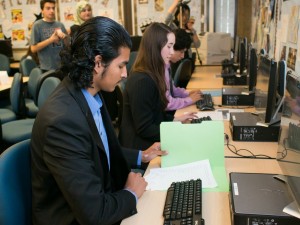
GUEST BLOG POST:
BY JENNIFER JOLLIFF AND SARA SMITH, PROGRAM COORDINATORS AT MISSION MIDDLE COLLEGE
Recently, we caught up with Jennifer Jolliff and Sara Smith, Program Coordinators at Mission Middle College, CA, to talk about their college bridge program in the Santa Clara School District. This collaboration gives high school seniors who are not performing well academically a second chance at making successful transitions to college.
In this blog, Jennifer and Sara describe how students with learning disabilities feel about attending college and their approach to provide a new learning environment. They also offer some great recommended reading resources.
Believing Students with LD Will Succeed
By 11th grade, Caleb was withdrawn and almost voiceless. His self-esteem had hit rock bottom. Due to his low reading ability, he felt ridiculed, ashamed, and beyond academic assistance. Caleb’s anxiety level was in overdrive as he talked with us about taking college courses. This young man was sensitive and smart, but lacked the transcripts and reading confidence to succeed. Sadly, many battle-scarred students, like Caleb, skip the quest to college for fear of failure.
Students with learning disabilities often lack the reading comprehension skills to handle college courses. They may be labeled as having an IEP (Individual Education Plan) or a 504. They may not have been formally diagnosed with a reading disability, such as dyslexia or dysgraphia, but are keenly aware that others have low expectations. They may believe that no one really believes they can succeed. Our task is to reverse this belief and provide a learning environment that wipes away this stigma.
About Mission Middle College Transition Program
Like many transition programs, our approach is to build a bridge to increase students’ confidence and give them alternative ways to learn. First, we equip them with technology. We encourage good study habits and teach them about emotional intelligence. These students want and deserve mutual respect.
To improve reading comprehension, we provide access to quality educational resources like Bookshare for students who qualify. Caleb liked reading accessible books with text-to-speech. This multisensory environment (seeing and hearing the content) reinforced reading comprehension.
Next, we connect students with peer mentors and provide resources for them to explore about learning disabilities. At the end of this article, we list reading recommendations to help parents.
Lastly, we set uniformly high expectations. Our learning environment at Mission Middle College applies cognitive-based theory with technology and instructional strategies that focus on reading comprehension. This combination helps the learner take ownership for their academic progress.

When we first met Caleb, he was fearful and unprepared. He responded favorably to using technology and accessible books. His reading comprehension improved. His barriers broke down and he believed he could succeed. His hard work paid off! Today, he attends East Texas Access University for religious studies. This is the type of success we want for all learners.
Recommended Reading Resources From Jennifer and Sara:
- 7 Steps to Success: High School to College Transition Strategies for Students with Disabilities by Elizabeth Hamblet
- Preparing Students with Disabilities for College Success: A Practical Guide to Transition Planning Paperback by Stan Shaw Ed.D. (Editor), Joseph Madaus Ph.D., Lyman Dukes Ph.D.
- Special Education Students with Learning Disabilities Transitioning from High School into Community Colleges by Ta-Tanisha A. Essex
- Transition Planning for Secondary Students with Disabilities, Edition 4, by Robert W. Flexer, Robert M. Baer, Pamela Luft, Thomas J. Simmons
- Mosaics of Thought: The Power of Comprehension Strategy Instruction by Ellin Oliver Steen and Susanne Zimmerman
- Building Transitional Programs for Students with Disabilities: How to Navigate the Course of Their Lives by Mahanay-Castro Christy Ph.D.
- Learning Outside the Lines: Two Ivy League Students with Learning Disabilities and ADHD Give You the Tools for Academic Success and Educational Revolution by Jonathan Mooney, David Cole, Edward M. Hallowell
Additional Resources:
- Bookshare Online Library Student Resources Special Collection
- The National Collaborative of Workforce and Disability Website for Youth
- The National Center of Learning Disabilities
- AHEAD (Association of Higher Education and Disabilities)
- National Secondary Transition Technical Assistance Center

P.S. Read this blog about Michael Yudin’s visit to Mission Middle College. Mr. Yudin is the Acting Assistant Secretary for the U.S. Office of Special Education and Rehabilitative Services.
Many thanks to Jennifer Jolliff, Sara Smith and Caleb Richardson, for sharing this information and update.

Be First to Comment